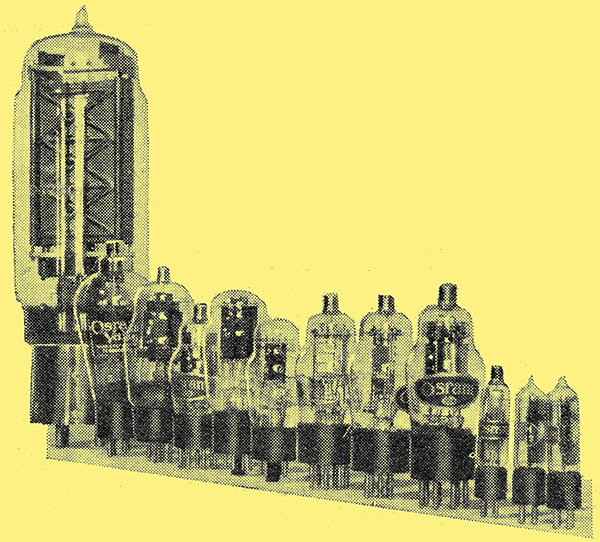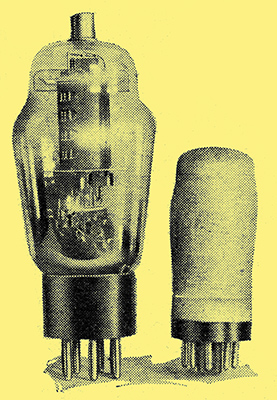|

A group of Osram valves ranging from the DA250 on the left to the deaf-aid types on the right.
To the casual observer the most striking tendency in the valve world must be the increase sin the number of different types of valve base. It would appear that each firm will soon have one, or even more, of its own!
All makers still retain the standard British bases with 4 to 9 pins for a wide range of valves and are still making additions with these bases. Last year Marconi and Osram introduced the American, or International, octal base for their 6.3 Volt series of valves with characteristics similar to those of American types. Quite recently, Mullard have marketed ya range of 6.3 Volt. valves with the Continental side-contact base, and Mazda have produced 2 Volt battery and 4 Volt mains valves with an octal-base which differs from the American. Tungsram market one range of valves with the American octal base, and another with the Continental side-contact, and this is in addition to other valves with the standard bases.
The valves in the Mullard and Tungsram ranges with the side-contact base are known as the E series and are characterised by possessing heaters which consume 0.2 A only in the case of most specimens. The valve of greatest interest is probably the EF8, which is intended for use as a first-stage amplifier. It is a hexode; the control grid surrounds the cathode and there are the usual screen and suppressor grids. Between the control and screen grids, however, there is an extra grid which is maintained at earth potential and which is wound turn for turn with the screen grid. As a result, the electrons are forced into beams so that the majority pass through the turns of the screen-grid without striking them. The screen current is thus abnormally low, being about 0.25 mA only, and the noise introduced by the valve is also low. It is claimed that through the use of this valve an increase in signal-noise ratio can be secured. Another valve in this range is the EF6 an RF pentode with an input resistance of 9 kΩ at 60 MHz.
These valves have mutual conductances of the order of 1.8-2.0 mA/V, and the adoption of these moderate figures, compared with those of a few years ago, does represent a distinct trend. Not only are these modest figures to be found in the E series of valves, but also in the Marconi and Osram International range. With the RF pentodes of these 6.3 Volt valves, the mutual conductances are some 1.2-1.6 mA/V and similar figures are to be found for earlier 4 Volt valves marketed by this firm such as the W42.
This tendency to adopt lower values of mutual conductance probably results largely from an increase in uniformity of different specimens coupled with some reduction in the cathode heating power. Moreover, for broadcast purposes high values of mutual conductance are usually unnecessary with modern circuit design.
This is by no means the case with television, however, and among valves intended for this purpose the aim is to get the highest possible mutual conductance with the lowest inter-electrode capacities. The one is of no use without the other, for if a doubling of the mutual conductance results in a doubling of the total circuit capacity, one is no better off. The Osram KTZ41 has a mutual conductance of 12 mA/V a very high figure for an RF tetrode. The Mazda SP42 has a mutual conductance of some 8.5 mA/ V, and by virtue of its octal base very low inter-electrode capacities are claimed.
Mullard, of course, retain the well-known TSP4, but now have a secondary emission valve, the EE50. This valve is of all-glass construction, the usual moulded base being absent. It has a mutual conductance under normal operating conditions of 14 mA /V. It takes 10 mA anode current at 250 Volts and 8 mA auxiliary cathode current. The heater has the standard rating of 6.3 Volts, 0.3 A, and the input and output capacities are respectively 7.3 pF and 7.1 pF.

The Mazda T41 gas-triode and AC6/Pen timebase output pentode.
For television time-base work Mazda have the T41 gas-triode. This is similar to the T31; but is intended for low voltage operation and is fitted with an octal base. For the output stage with magnetic deflection this firm has the AC6/Pen; this is substantially the same as the AC4/Pen, but has a top-anode connection so that it can withstand the high peak voltages generated on the fly-back.
Osram have the KT8, a top-anode tetrode, which is otherwise similar to the KT66. Although suitable for television work it is classed as a transmitting valve and is rated for 600 Volts anode potential. As an RF amplifier for Class C telegraphy it has the useful output of 25 Watts at 60 MHz. A larger valve is the DET14; it has a 7.5 Volt 3 A filament, and is a triode rated for 1,500 Volts and 55 Watts anode dissipation. Among large output valves made by this firm must be mentioned the DA250, a pair of which in Class AB2 will give an output of 800 Watts.
Turning now to cathode-ray tubes, there is an obvious tendency towards the production of shorter types. Such tubes are invariably of the magnetic type, and although the reduction in length is advantageous from the point of view of cabinet size it is not without its attendant drawbacks. The short tubes need more carefully designed deflecting coils if an undistorted spot is to be obtained in the corners of the picture, and a considerably greater deflecting power is needed.
In general, magnetic tubes have only the cathode assembly, control grid and anode, and the Ediswan tubes are of this type. The Mullard tubes, however, have an additional anode which is maintained at about 100-250 Volts. Both these firms still list their older electrostatic types, of course, and Cossor also make both kinds. This firm, however, lists chiefly electrostatic models and has a very wide range of types for both television and oscilloscope uses.
GEC have two small oscilloscope tubes with screens of some 1.5 in and 2.5 in diameter, while Hivac have a 3 in model. The very small tubes need only about 300-500 Volts for good operation, and the larger types some 600-1,000 Volts, so that their use becomes quite economical.
Vacuum Science Products have a range of cathode-ray tubes which are especially interesting since they differ in several ways from what is fast becoming standard practice. In the first place the tubes are unusually long and so require an unusually low deflecting power. Secondly, a different modulating system is used; instead of employing the cathode shield for this purpose, a separate grid is interposed between the cathode shield and first anode. It is claimed that an input of only 6 Volts p-p is needed for modulation. Tubes are available for all electrostatic or all magnetic deflection and focusing, or for a combination of the two.
Of particular interest to set makers is a tube with a built-in picture which can be used to provide a standard picture for test purposes. The amplifier needed can be an electron multiplier, types of which are produced by this firm, as well as a wide variety of photo-electric cells.
|